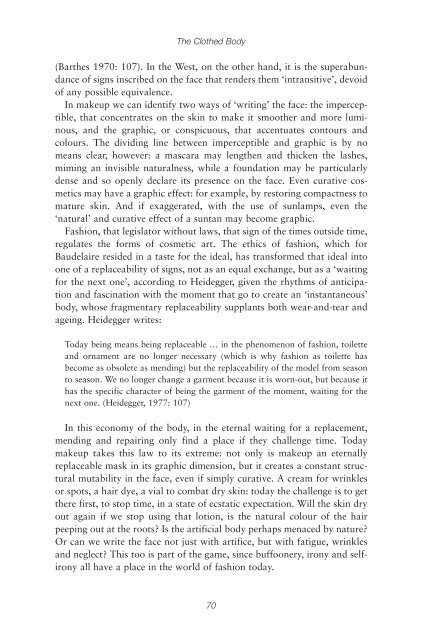You also want an ePaper? Increase the reach of your titles
YUMPU automatically turns print PDFs into web optimized ePapers that Google loves.
<strong>The</strong> <strong>Clothed</strong> <strong>Body</strong><br />
(Barthes 1970: 107). In the West, on the other hand, it is the superabundance<br />
of signs inscribed on the face that renders them ‘intransitive’, devoid<br />
of any possible equivalence.<br />
In makeup we can identify two ways of ‘writing’ the face: the imperceptible,<br />
that concentrates on the skin to make it smoother and more luminous,<br />
and the graphic, or conspicuous, that accentuates contours and<br />
colours. <strong>The</strong> dividing line between imperceptible and graphic is by no<br />
means clear, however: a mascara may lengthen and thicken the lashes,<br />
miming an invisible naturalness, while a foundation may be particularly<br />
dense and so openly declare its presence on the face. Even curative cosmetics<br />
may have a graphic effect: for example, by restoring compactness to<br />
mature skin. And if exaggerated, with the use of sunlamps, even the<br />
‘natural’ and curative effect of a suntan may become graphic.<br />
Fashion, that legislator without laws, that sign of the times outside time,<br />
regulates the forms of cosmetic art. <strong>The</strong> ethics of fashion, which for<br />
Baudelaire resided in a taste for the ideal, has transformed that ideal into<br />
one of a replaceability of signs, not as an equal exchange, but as a ‘waiting<br />
for the next one’, according to Heidegger, given the rhythms of anticipation<br />
and fascination with the moment that go to create an ‘instantaneous’<br />
body, whose fragmentary replaceability supplants both wear-and-tear and<br />
ageing. Heidegger writes:<br />
Today being means being replaceable … in the phenomenon of fashion, toilette<br />
and ornament are no longer necessary (which is why fashion as toilette has<br />
become as obsolete as mending) but the replaceability of the model from season<br />
to season. We no longer change a garment because it is worn-out, but because it<br />
has the specific character of being the garment of the moment, waiting for the<br />
next one. (Heidegger, 1977: 107)<br />
In this economy of the body, in the eternal waiting for a replacement,<br />
mending and repairing only find a place if they challenge time. Today<br />
makeup takes this law to its extreme: not only is makeup an eternally<br />
replaceable mask in its graphic dimension, but it creates a constant structural<br />
mutability in the face, even if simply curative. A cream for wrinkles<br />
or spots, a hair dye, a vial to combat dry skin: today the challenge is to get<br />
there first, to stop time, in a state of ecstatic expectation. Will the skin dry<br />
out again if we stop using that lotion, is the natural colour of the hair<br />
peeping out at the roots? Is the artificial body perhaps menaced by nature?<br />
Or can we write the face not just with artifice, but with fatigue, wrinkles<br />
and neglect? This too is part of the game, since buffoonery, irony and selfirony<br />
all have a place in the world of fashion today.<br />
70

















